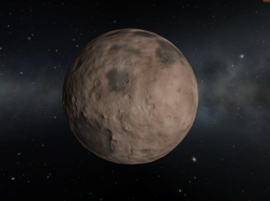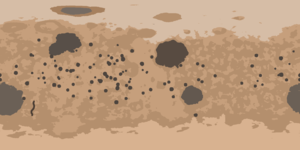Difference between revisions of "Moho"
(improved lead section) |
m (]) |
||
| Line 1: | Line 1: | ||
{{Infobox/Body}} | {{Infobox/Body}} | ||
| − | '''Moho''' is the second-largest planet and the one closest to [[Kerbol]], with an orbital period of 102 days, the shortest in the [[Kerbol System|Kerbol system]], and an orbital velocity ranging from 12-18km/s, is also the fastest [[celestial body]] in [[Kerbal Space Program]]. It is the [[w:Mercury (planet)|Mercury]] analogue. Moho lacks [[atmosphere]] and natural satellites. The planet gets its name from the [https://en.wikipedia.org/wiki/Mohorovi%C4%8Di%C4%87_discontinuity ''Moho''rovičić discontinuity], the boundary between the [[w:Earth|Earth]]'s crust and mantle. | + | '''Moho''' is the second-largest planet and the one closest to [[Kerbol]], with an orbital period of 102 days, the shortest in the [[Kerbol System|Kerbol system]], and an orbital velocity ranging from 12-18km/s, is also the fastest [[celestial body]] in [[Kerbal Space Program]]. It is the [[w:Mercury (planet)|Mercury]] analogue. Moho lacks an [[atmosphere]] and natural satellites. The planet gets its name from the [https://en.wikipedia.org/wiki/Mohorovi%C4%8Di%C4%87_discontinuity ''Moho''rovičić discontinuity], the boundary between the [[w:Earth|Earth]]'s crust and mantle. |
Moho's inclined, low, and eccentric [[orbit]] and lack of atmosphere or moons (for [[aerobraking]] and [[Tutorial: Gravity Assist|gravity assist]]s, respectively) make [[encountering]] the planet relatively difficult. Without an atmosphere to retain or block heat, Moho's daytime surface temperatures can exceed 300°C, making [[radiator]]s an absolute necessity if any [[part]] (such as drills or engines) must be cool to operate both safely and effectively. | Moho's inclined, low, and eccentric [[orbit]] and lack of atmosphere or moons (for [[aerobraking]] and [[Tutorial: Gravity Assist|gravity assist]]s, respectively) make [[encountering]] the planet relatively difficult. Without an atmosphere to retain or block heat, Moho's daytime surface temperatures can exceed 300°C, making [[radiator]]s an absolute necessity if any [[part]] (such as drills or engines) must be cool to operate both safely and effectively. | ||
| Line 14: | Line 14: | ||
== Topography == | == Topography == | ||
| − | Moho's surface ranges from light brown highlands to dark brown basins, possibly the product of [[w:volcanism|volcanism]. Its highest point is in its northern hemisphere at an altitude of 6817 m. Moho's heavy cratering suggests erosion caused by tidal friction with Kerbol. | + | Moho's surface ranges from light brown highlands to dark brown basins, possibly the product of [[w:volcanism|volcanism]]. Its highest point is in its northern hemisphere at an altitude of 6817 m. Moho's heavy cratering suggests erosion caused by tidal friction with Kerbol. |
Moho has a very deep well at its geographic north pole, called the Northern Sinkhole. The Mohole is about 4.6 kilometers deep.<ref>“[[thread:48006|Moho's Secrets Revealed]]” </ref> The hole is a glitch in the procedural generation of terrain; many other bodies with land at the north pole have similar bugs.<ref>https://www.youtube.com/watch?v=-e5SGynBJ4Y</ref> Despite,the appearance of another hole at the geographic south pole in [[Map View]], one does not exist. | Moho has a very deep well at its geographic north pole, called the Northern Sinkhole. The Mohole is about 4.6 kilometers deep.<ref>“[[thread:48006|Moho's Secrets Revealed]]” </ref> The hole is a glitch in the procedural generation of terrain; many other bodies with land at the north pole have similar bugs.<ref>https://www.youtube.com/watch?v=-e5SGynBJ4Y</ref> Despite,the appearance of another hole at the geographic south pole in [[Map View]], one does not exist. | ||
Revision as of 15:20, 18 March 2016
| Moho | ||
| Moho as seen from orbit. | ||
| Planet of Kerbol | ||
| Orbital Characteristics | ||
| Semi-major axis | 5 263 138 304 m [Note 1] | |
| Apoapsis | 6 315 765 981 m [Note 1] | |
| Periapsis | 4 210 510 628 m [Note 1] | |
| Orbital eccentricity | 0.2 | |
| Orbital inclination | 7 ° | |
| Argument of periapsis | 15 ° | |
| Longitude of the ascending node | 70 ° | |
| Mean anomaly | 3.14 rad (at 0s UT) | |
| Sidereal orbital period | 2 215 754 s | |
| 102 d 3 h 29 m 14.2 s | ||
| Synodic orbital period | 2 918 346.4 s | |
| Orbital velocity | 12 186 - 18 279 m/s | |
| Physical Characteristics | ||
| Equatorial radius | 250 000 m | |
| Equatorial circumference | 1 570 796 m | |
| Surface area | 7.8539816×1011 m2 | |
| Mass | 2.5263314×1021 kg | |
| Standard gravitational parameter | 1.6860938×1011 m3/s2 | |
| Density | 38 599.500 kg/m3 | |
| Surface gravity | 2.70 m/s2 (0.275 g) | |
| Escape velocity | 1 161.41 m/s | |
| Sidereal rotation period | 1 210 000.0 s | |
| 56 d 0 h 6 m 40 s | ||
| Solar day | 2 665 723.4 s | |
| 123 d 2 h 28 m 43.4 s | ||
| Sidereal rotational velocity | 1.2982 m/s | |
| Synchronous orbit | Outside sphere of influence | |
| Sphere of influence | 9 646 663.0 m [Note 1] | |
| Atmospheric Characteristics | ||
| Atmosphere present | No | |
| Scientific multiplier | ||
| Surface | 10 | |
| Splashed | N/A | |
| Near space | 8 | |
| Outer space | 7 | |
| Recovery | 7 | |
|
| ||
Moho is the second-largest planet and the one closest to Kerbol, with an orbital period of 102 days, the shortest in the Kerbol system, and an orbital velocity ranging from 12-18km/s, is also the fastest celestial body in Kerbal Space Program. It is the Mercury analogue. Moho lacks an atmosphere and natural satellites. The planet gets its name from the Mohorovičić discontinuity, the boundary between the Earth's crust and mantle.
Moho's inclined, low, and eccentric orbit and lack of atmosphere or moons (for aerobraking and gravity assists, respectively) make encountering the planet relatively difficult. Without an atmosphere to retain or block heat, Moho's daytime surface temperatures can exceed 300°C, making radiators an absolute necessity if any part (such as drills or engines) must be cool to operate both safely and effectively.
Contents
In-game Description
| “ | Moho figures in Kerbal mythology as a fiery place with oceans of flowing lava. In reality, however, it's much less interesting. Scientists speculate about possible ways to make it awesome like in the stories. Some of those ideas have led to new breakthroughs in aerospace technology. |
” |
Topography
Moho's surface ranges from light brown highlands to dark brown basins, possibly the product of volcanism. Its highest point is in its northern hemisphere at an altitude of 6817 m. Moho's heavy cratering suggests erosion caused by tidal friction with Kerbol.
Moho has a very deep well at its geographic north pole, called the Northern Sinkhole. The Mohole is about 4.6 kilometers deep.[1] The hole is a glitch in the procedural generation of terrain; many other bodies with land at the north pole have similar bugs.[2] Despite,the appearance of another hole at the geographic south pole in Map View, one does not exist.
The Mohole can destroy craft and kill Kerbals that fall into it.
Biomes
Moho has 12 biomes. It is one of two bodies (the other being Ike) that have their own North and South Pole biome.
Biome list
|
Orbital Statistics
Mohosynchronous and semi-synchronous orbits are impossible — they would require altitudes of 18 182.08 km and 11 361.48 km respectively, both of which are beyond Moho's sphere of influence.
Reference Frames
| Time warp | Minimum Altitude |
|---|---|
| 1× | Any |
| 5× | 10 000 m |
| 10× | 10 000 m |
| 50× | 30 000 m |
| 100× | 50 000 m |
| 1 000× | 100 000 m |
| 10 000× | 200 000 m |
| 100 000× | 300 000 m |
Solar System Counterpart
Moho is the apparent Kerbol System analog of the planet Mercury. Both share a similar cratered landscape, like most bodies with little to no atmosphere. Due to the lack of an atmosphere to retain heat, Moho and Mercury are freezing on the night side and, relative to Earth, extremely hot on the day side. Both planets are the closest to their respective stars and lack natural satellites.
However, Moho has a brown surface, while Mercury has a dark grey surface. In addition, Mercury has a tenuous atmosphere of about 10⁻¹³ kPa while Moho has no atmosphere; although, a pressure of 10⁻¹³ kPa (≃ 10⁻¹⁵ atm) would be rendered "unmeasurable" by the PresMat Barometer and register in KSP as a vacuum.
Gallery
Bill Kerman having the time of his life wedged in the Northern Mohole.
Hanny Kerman wedged in the Northern Mohole sideways. Lots of orientation jittering was observed.
Changes
- Added biomes
- New, procedurally generated, textures added, with higher detail craters.
- Entirely changed more cratered surface.
- Color changed from red to brown.
- No more superheated atmosphere.
- No longer tidally locked.
- Mass reduced.
- Initial Release








